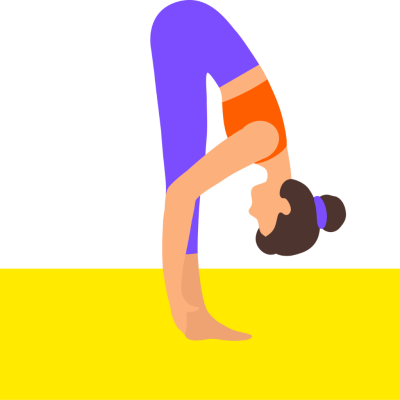Techniques and Postures of Surya Namaskara
The word Surya means “Sun” and the word Namaskara means “Worship”. Therefore, this practice is known as the ‘salutation of the Sun’. It consists of five basic elements: Physical postures, Breathing, Mantras, Awareness, and Relaxation.

Hasta Uttanasana
Hasta Uttanasana (The raised arm pose)
Raise both arms above the head, keeping hands separated by a shoulder’s width.
At the end of the movement bend the head, arms and upper trunk backwards.
The palms should face forwards
The movement should be executed in one smooth motion with awareness.
Inhale while raising the arms.

Ashwa Sanchalasana
Ashwa Sanchalasana (The equestrian pose)
Stretch the right leg backwards as far as you can.
Bend the left leg at the knee, but keeping the left foot in the same position.
The palms should remain on the floor and the arms should remain straight.
The movement should be executed smoothly and with awareness.
Inhale deeply as you move the body.

Ashtanga Namaskara
Asthanga Namaskara (Worship with eight points)
The position is so called because in the final pose 8 points of the body are in contact with the ground.
Lower the body to the ground, first bending the legs and placing the knees in contact with the floor.
Bend the arms and lower the head and trunk towards the ground.
Raise the andomen and hips slightly off the ground.
In the final position the 8 Points should be on the ground: the chin, the chest, 2palms, 2 knees, and the finger of the both feet.
Hold the breath outside, Don’t breathe in.

Pranamasana
Pranamasana (The Prayer Pose):
Stand Erect with the feet together.
Face the Sun or the direction of the Sun.
Place the two palms together in front of the chest in an Position of prayer, the namaskara mudra.
Close the eyes and relax the whole body.
Be aware of the body for at least half a minute.
Breathe normally with full awareness.

Padahastasana
Padahastasana (The forward bending pose)
Bend forwards and place the palms of the hands on the floor, either in front of or on each side of the feet
The movement should be continuous and without any jerking keep the legs straight.
Exhale as deeply as possible while bending forwards.

Parvatasana
Parvatasana (The mountain pose)
Raise your right knee.
Lower your heads towards the floor and bend the back to move the buttocks upward.
Stretch the left leg backwards and place the left foot beside the right foot.
Raise the buttocks as high as possible into the air and further lower the head so that it lies between the two arms.
The legs should be straightened in the final position.
Press the heels of both feet towards the ground.
The must remain straight and the hands and right foot should remain in contact with the floor.
Exhale deeply as you perform the movement.

Bhujangasana
Bhujangasana (The cobra pose)
Lower the hips to the ground.
Straighten the arms so that the head and back move upward.
In the final position the head and back should be bent backwards as far as is comfortable, but try to keep the abdomen as close as possible to the floor, without straining
The position of the hands and feet should not change throughout the movement.
Inhale deeply during the movement.
After this asana there are five more asanas which we had seen in the starting Parvatasana, Ashwa sanchalasana, Padahastasana, Hasta uttanasana, Pranamasana.
Information
- Shyam plaza , Third floor, room no.3, Pandri road.
- +91 626 818 1142
- yogram5@gmail.com
COMPANY
Menu
